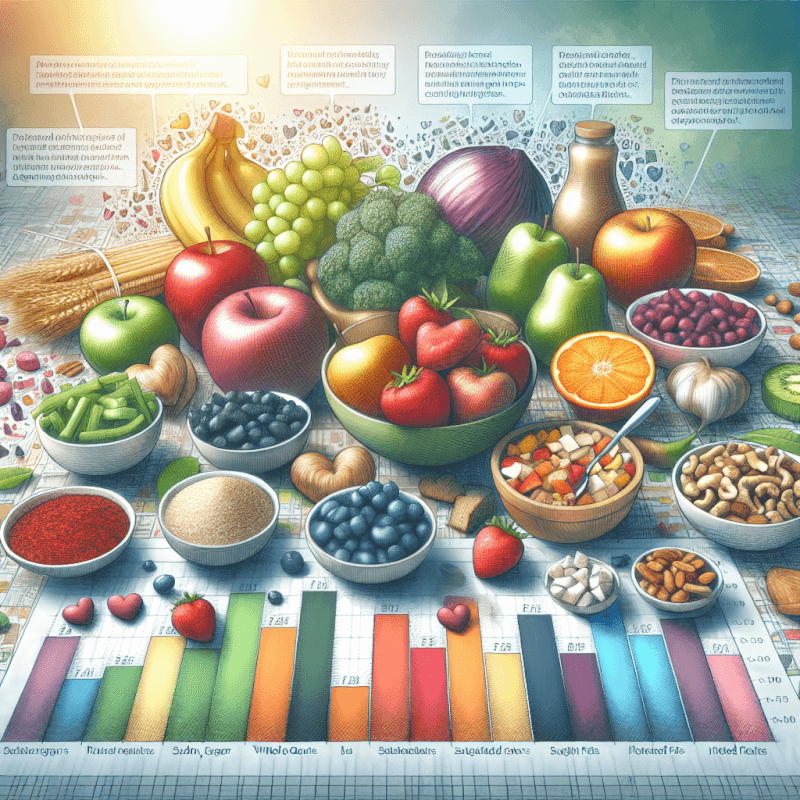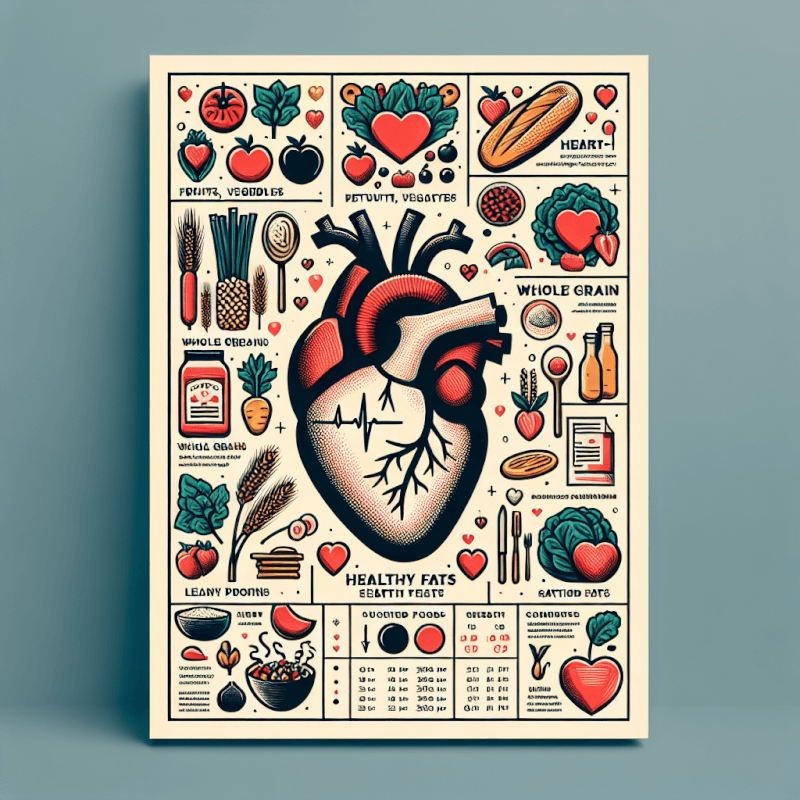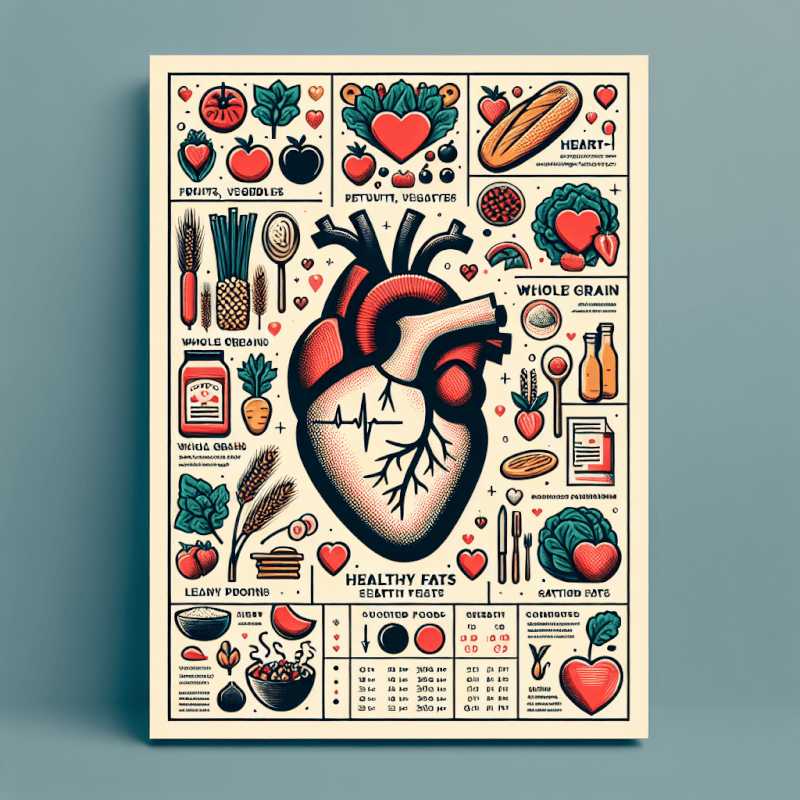Maintaining a heart-healthy diet is crucial for your overall well-being, but do you know what key components it should consist of? In this article, we will explore the essential elements that make up a heart-healthy diet. By understanding these components, you can make informed choices about your eating habits and take proactive measures to improve your heart health. So, let’s dive into the world of nutritious foods that can keep your heart strong and thriving!

Overview of a Heart-Healthy Diet
Maintaining a heart-healthy diet is essential for promoting cardiovascular health and reducing the risk of heart disease. A heart-healthy diet emphasizes nutrient-rich whole foods while minimizing the consumption of unhealthy fats, processed foods, and added sugars. In this comprehensive article, we will explore the key components of a heart-healthy diet and provide valuable insights and tips for incorporating these components into your daily life.
1. Whole Grains
1.1 Importance of Whole Grains
Whole grains play a crucial role in a heart-healthy diet. Unlike refined grains, such as white bread and white rice, whole grains retain their natural fiber content and vital nutrients. The consumption of whole grains has been linked to a lower risk of heart disease, high blood pressure, and stroke. The fiber in whole grains helps to reduce cholesterol levels and maintain healthy blood pressure, contributing to a healthier heart.
1.2 Examples of Whole Grains
Incorporating whole grains into your diet is easier than you might think. Some examples of whole grains include whole wheat, barley, oats, quinoa, brown rice, and buckwheat. These grains can be enjoyed in various forms such as bread, pasta, cereals, and side dishes. Start by swapping refined grain products with their whole grain alternatives to reap the benefits of these heart-healthy options.
2. Healthy Fats
2.1 Monounsaturated Fats
Healthy fats, such as monounsaturated fats, are an essential component of a heart-healthy diet. Monounsaturated fats can help reduce bad cholesterol levels in the blood, which in turn lowers the risk of heart disease and stroke. Foods rich in monounsaturated fats include avocados, olive oil, nuts, and seeds. Incorporating these healthy fats into your meals can be as simple as drizzling olive oil over your salad or enjoying a handful of almonds as a snack.
2.2 Polyunsaturated Fats
Polyunsaturated fats are another type of healthy fat that should be included in a heart-healthy diet. They are known to lower bad cholesterol levels and reduce inflammation in the body. Good sources of polyunsaturated fats include fatty fish, such as salmon and trout, as well as walnuts, flaxseeds, and soybean oil. Adding these nutritious foods to your diet can help protect your heart and improve overall cardiovascular health.
2.3 Omega-3 Fatty Acids
Omega-3 fatty acids, a type of polyunsaturated fat, deserve special attention due to their numerous heart-healthy benefits. Studies have shown that omega-3 fatty acids can reduce the risk of arrhythmias, decrease triglyceride levels, and lower blood pressure. Fatty fish like salmon, mackerel, and sardines are excellent sources of omega-3 fatty acids. For those who don’t consume fish, omega-3 supplements or plant-based sources like walnuts and flaxseeds can be beneficial.
2.4 Avoiding Trans Fats
While healthy fats are essential for a heart-healthy diet, it is equally important to avoid trans fats. Trans fats are artificially created fats that increase bad cholesterol levels and decrease good cholesterol levels, leading to an increased risk of heart disease. To minimize trans fat consumption, it is crucial to read food labels carefully and avoid foods that contain partially hydrogenated oils, which are the primary source of trans fats.
3. Lean Proteins
3.1 Benefits of Lean Proteins
Adding lean proteins to your meals is an important component of a heart-healthy diet. Lean proteins, such as skinless poultry, fish, legumes, and tofu, are lower in saturated fats compared to fatty cuts of meat. Consuming lean proteins provides essential amino acids for building and repairing tissues, without the added detriment of excessive saturated fats. This can help reduce the risk of heart disease and maintain a healthy weight.
3.2 Sources of Lean Proteins
Incorporating lean proteins into your diet can be both delicious and versatile. Opt for skinless chicken or turkey breast, as they contain less saturated fat than darker meat cuts. Fish, especially fatty fish like salmon and tuna, are excellent choices as they provide heart-healthy omega-3 fatty acids. Legumes, such as lentils, chickpeas, and beans, are not only rich in protein but also contain dietary fiber, which aids in maintaining healthy cholesterol levels. Tofu and other soy-based products are great plant-based options for those following a vegetarian or vegan lifestyle.

4. Fruits and Vegetables
4.1 Importance of Fruits and Vegetables
Fruits and vegetables are at the core of a heart-healthy diet. They are rich in essential vitamins, minerals, and dietary fiber while being low in calories and unhealthy fats. Regular consumption of fruits and vegetables has been associated with a reduced risk of heart disease, stroke, and high blood pressure. These nutrient powerhouses provide antioxidants, which help combat inflammation and protect the heart.
4.2 Recommended Serving Sizes
To maximize the benefits of fruits and vegetables in your diet, it is recommended to consume a variety of colors and types. Aim to fill half your plate with fruits and vegetables at each meal. Incorporating a rainbow of colors, such as leafy greens, berries, citrus fruits, bell peppers, and sweet potatoes, ensures a diverse range of essential nutrients. Snacking on raw or lightly steamed vegetables and incorporating fruits in desserts or smoothies are excellent ways to increase your intake.
5. Low-Fat Dairy Products
5.1 Role of Low-Fat Dairy in Heart Health
Low-fat dairy products, such as skim milk, low-fat yogurt, and reduced-fat cheese, can be a part of a heart-healthy diet. They are excellent sources of calcium, potassium, and vitamin D, which are essential for maintaining bone health and regulating blood pressure. While some individuals may choose to avoid dairy due to lactose intolerance or dietary preferences, those who can tolerate it can benefit from the nutritional value that low-fat dairy products provide.
5.2 Choosing Low-Fat Dairy Options
When selecting low-fat dairy products, it is important to read labels and choose options that are free from added sugars. Consider unsweetened plain yogurt, which can be flavored with fresh fruits or a drizzle of honey, instead of flavored yogurts that are often packed with added sugars. Opt for skim or 1% milk instead of whole milk, and choose reduced-fat cheese over full-fat varieties. These simple swaps can significantly reduce the intake of saturated fats while still enjoying the benefits of low-fat dairy.

6. Sodium Control
6.1 Understanding Sodium’s Impact on Heart Health
Controlling sodium intake is crucial for maintaining heart health. Consuming excessive amounts of sodium can contribute to high blood pressure, a major risk factor for heart disease. Reducing sodium intake can help manage blood pressure levels and reduce the strain on the cardiovascular system. It is important to note that sodium is not only found in table salt but is also present in many processed and packaged foods.
6.2 Reducing Sodium Intake
To reduce sodium intake, it is essential to make mindful choices and read food labels carefully. Opt for fresh or minimally processed foods, as they generally contain lower amounts of sodium compared to processed foods. Limit the use of table salt while cooking and flavor your dishes with herbs, spices, and other salt-free seasonings. Be cautious of condiments, sauces, and canned goods, as they often contain high levels of sodium. By gradually reducing your sodium intake, you can protect your heart and improve overall cardiovascular health.
7. Limiting Added Sugars
7.1 Effects of Added Sugars on Heart Health
Limiting the consumption of added sugars is vital for a heart-healthy diet. Diets high in added sugars have been linked to an increased risk of obesity, type 2 diabetes, and heart disease. Excessive sugar intake can lead to weight gain, elevated triglyceride levels, and higher blood pressure, all of which contribute to an unhealthy heart. It is important to distinguish between naturally occurring sugars found in fruits and vegetables and the added sugars present in processed foods and sugary beverages.
7.2 Minimizing Added Sugar in the Diet
Reducing added sugar intake can be challenging in a society where sugary snacks and drinks are widely available. However, making small changes to your eating habits can make a significant impact on your cardiovascular health. Choose water or unsweetened beverages over sugary drinks, limit the consumption of sweets and desserts, and read food labels to identify hidden sources of added sugars. Focus on whole, unprocessed foods and use natural sweeteners like honey or maple syrup when needed. By reducing added sugar in your diet, you are taking a vital step towards a healthier heart.

8. Portion Control
8.1 Importance of Portion Control
Practicing portion control is an important aspect of a heart-healthy diet. Overeating can lead to weight gain and increase the risk of heart disease and other chronic conditions. Paying attention to portion sizes ensures that you consume the appropriate amount of nutrients while avoiding excessive calorie intake. It is essential to listen to your body’s hunger and fullness cues and develop a healthy relationship with food.
8.2 Tips for Portion Control
To manage portion sizes effectively, there are several strategies you can implement. Start by using smaller plates and bowls to create the illusion of a fuller portion. Measure out appropriate servings of foods, especially calorie-dense items like nuts and oils, to avoid unintentional overeating. Fill half of your plate with vegetables and divide the remaining space for lean proteins and whole grains. Eating slowly and savoring each bite allows your body to register fullness more accurately. By practicing portion control, you can maintain a balanced diet and support a healthy heart.
10. Incorporating Physical Activity
10.1 Benefits of Exercise for Heart Health
Incorporating regular physical activity into your daily routine is paramount to maintaining a heart-healthy lifestyle. Exercise helps to improve cardiovascular fitness, strengthen the heart muscle, lower blood pressure, and manage weight. Engaging in regular physical activity has also been shown to reduce the risk of heart disease and improve overall mental health.
10.2 Recommended Exercise Guidelines
The American Heart Association recommends at least 150 minutes of moderate-intensity aerobic activity or 75 minutes of vigorous-intensity aerobic activity per week. This can be achieved through activities such as brisk walking, jogging, cycling, swimming, or dancing. Additionally, strength training exercises two or more days a week are recommended to strengthen muscles and improve overall fitness. It is important to consult with a healthcare professional before starting or significantly increasing your exercise routine, especially if you have any underlying health conditions.
By incorporating moderate-intensity physical activity into your routine, you can effectively promote heart health and improve overall well-being.
In conclusion, a heart-healthy diet consists of whole grains, healthy fats, lean proteins, fruits and vegetables, low-fat dairy products, limited sodium intake, minimized added sugars, portion control, and regular physical activity. By embracing these key components and making positive lifestyle choices, you can prioritize your heart health and reduce the risk of heart disease. Remember, small changes in your daily habits can add up to significant improvements in your cardiovascular health.



